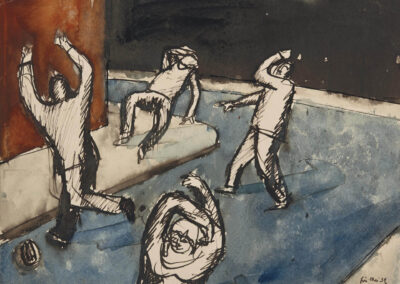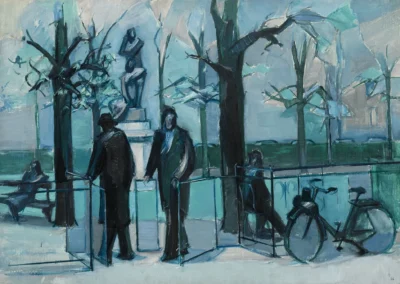Our next Artist You Need To Know is Jean Hélion (1904–1987).
Hélion (1904 – 1987) was a French painter who “worked with both non-objective and figurative painting over the course of his career, often straddling the two” : his abstract compositions (specifically from the 1930s) brought him to the forefront of modernism. However, in the middle of his career he began to work in a more figurative style, and for nearly half a century would produce more narrative and illustrative paintings but still with a focus on colour and line. Hélion also published several books and was a critical thinker in the space of artmaking through his career.
“I understand abstract art as an attempt to feed the imagination with a world built through the basic sensations of the eyes.”
Jean Hélion was born in 1904 in Couterne, France : he initially studied chemistry at l’Institut Industriel du Nord in Lille but lost interest in this field and moved to Paris in 1921 working as an architect’s assistant. During this period, Hélion visted the Louvre often, and was greatly influenced by the artworks of Nicolas Poussin and Philippe de Champaigne, and decided to become a painter. After leaving his position with the architectural firm in 1925 Hélion began figure drawing classes at the Académie Adler.
Several years later he was part of a larger community of artists that included Otto Freundlich and Joaquín Torres-García. After a foray into Cubism, Hélion found he was more interested in the ideas and work of contemporary artists like Piet Mondrian and Max Ernst.
As WW II raged in Europe, Hélion became a member of the French Resistance Army in 1941 but was captured and spent two years as a prisoner of war.
Following his release at the end of WW II, Hélion stopped working in ‘pure abstraction’ : he began to incorporated more figurative elements, and his works often had an affinity with the illustrative and colourful paintings of Fernand Léger.
“Jean Hélion started out as an abstract artist, but later moved on to figurative painting. But that doesn’t mean he abandoned the abstract principles: his paintings, resembling cartoon strips, are life-like but elaborate arrangements of shapes and colors.” (from here)
Hélion’s vision began to fail in the 1970s and in 1983 he lost his eyesight completely due to a brain tumour. However, Hélion would publish three books about art and aestherics during this period. From one of these texts (Mémoire de la chambre jaune, which was published posthumously in 1994) Hélion asserted that he had “sought out the voice of painting wherever it sings loudest. No doubt, in complete abstraction one has the feeling of a great shock, if not an explosion, and in approaching the real, one feels health and truth restored. The whole import of the successive periods of my work was to combine the two.”
Although Hélion’s return to more illustrative work was considered controversial in some artistic circles (critics and historians often praise his abstract paintings while dismissing his other later artworks), he was an important influence on a number of younger artists, including Roy Lichtenstein.
Hélion’s work can be found in numerous French museums (such as Centre Georges Pompidou in Paris) but also sites such as the Museum of Modern Art (New York), the Art Institute of Chicago, the Buffalo AKG (formerly the Albright-Knox Art Gallery, Buffalo, New York), the North Carolina Museum of Art, the Kunsthalle Hamburg, the Peggy Guggenheim Collection in Venice and the Tate Gallery (London, UK). As well, the majority of artist’s notebooks are preserved in the Bibliothèque Nationale in Paris.
Jean Hélion died in Paris on October 27, 1987. Much more about his career and work can be seen here at The Association Jean Hélion which is an extensive resource for Hélion’s life and legacy with a great deal of information about past exhibitions and collections that hold his work. A number of his artworks that span his career can also be enjoyed here.






























